Large-Deformation Modeling of Surface Instability and Ground Collapse during Tunnel Excavation by Material Point Method
Abstract
:1. Introduction
2. MPM-Based Numerical Framework and Its Validation
2.1. MPM-Based Numerical Model
2.2. MPM Validation Based on a Benchmark Example
3. Numerical Simulation of Tunnel Excavation in a Soil Stratum
4. Results and Discussions
5. Implications and Limitations
5.1. Implications of This Study for Underground Construction
- (1)
- When determining the spacing and range of monitoring points for measuring ground displacement, reference to the deformation and collapse results of overlaying strata with varying thickness, cohesion, and friction angle should be made;
- (2)
- Regarding the tunnel boring machine, its primary construction technical parameters, such as advance rate, propelling pressure, cutter thrust, and torque, could be adjusted flexibly based on soil layer information;
- (3)
- To address weakened soil layers, measures aimed at enhancing material cohesion and internal friction angle should be implemented to prevent excessive deformation and ground collapse during tunneling.
5.2. Limitations of This Study
- (1)
- This study employed a two-dimensional (2D) plane strain model to simulate the deformation of overlaying strata during tunnel excavation. While previous studies [39,53,54] have demonstrated the similarity between the predicted results of the 2D model and those of the 3D model, it is still necessary to establish an MPM-based 3D model to more accurately reflect the stress state of the stratum during tunneling;
- (2)
- This study assumed homogeneity in the overlaying strata and neglected the existence of pore water pressure in the soil mass, which may not align with practical conditions. Considering the stratification of the foundation, future work should incorporate a numerical model that accounts for various soil layers, thicknesses, and soil contact angles.
6. Conclusions
- (1)
- Numerical predictions from the benchmark example in Section 2.2 and the case model in Section 3 as well as Section 4 show that the MPM-based method effectively simulates large deformations and offers a comprehensive, systematic description of tunnel-induced surface instability and collapses. This approach enables proactive, informed tunnel design and construction strategies to prevent collapses.
- (2)
- Ground collapse during tunneling is shaped by the evolution of shear bands at the tunnel’s ends. Thinner soil layers increase the shear band’s inclination angle, whereas thicker layers decrease it, leading to varied collapse depths and widths depending on the strata thickness.
- (3)
- The cohesive strength and internal friction angle minimally impact the failure patterns and displacement modes of overlying strata during tunneling. However, increasing soil cohesion and internal friction angles significantly reduces the extent of localized plastic zones and ground subsidence.
- (4)
- The pattern of change in the longitudinal settlement of the ground surface with the development of deformation is investigated. In general, the depth and width of the crater gradually increased, while the location of the maximum depth was gradually closer to the initial position of the tunnel face.
Author Contributions
Funding
Data Availability Statement
Conflicts of Interest
References
- Liang, Y.; Chen, X.Y.; Yang, J.S.; Zhang, J.; Huang, L.C. Analysis of ground collapse caused by shield tunnelling and the evaluation of the reinforcement effect on a sand stratum. Eng. Fail. Anal. 2020, 115, 104616. [Google Scholar] [CrossRef]
- Wang, R.H.; Li, D.Q.; Chen, E.J.; Liu, Y. Dynamic prediction of mechanized shield tunneling performance. Autom. Constr. 2021, 132, 103958. [Google Scholar] [CrossRef]
- Zhang, W.G.; Zhong, H.Y.; Xiang, Y.Z.; Wu, D.F.; Zeng, Z.K.; Zhang, Y.M. Visualization and digitization of model tunnel deformation via transparent soil testing technique. Undergr. Space 2022, 7, 564–576. [Google Scholar] [CrossRef]
- Chen, X.J.; Hu, Y.; Zhang, L.; Liu, Y. 3D large–deformation modelling on face instability and sinkhole formation during tunnelling through non–uniform soils. Tunn. Undergr. Space Technol. 2023, 134, 105011. [Google Scholar] [CrossRef]
- Ground Collapse Adjacent to Metro Line 2 of Xiamen. Available online: https://news.ifeng.com/c/7sNCmxmkKQq (accessed on 13 December 2019).
- Ground Collapse Induced by the Construction of the I Phase of Foshan Metro Line 2. Available online: https://www.sohu.com/a/221699076_270606 (accessed on 2 August 2018).
- Road Collapse of Jianguo North Road in Hangzhou. Available online: http://k.sina.com.cn/article_1686546714_6486a91a02000rhva.html (accessed on 28 August 2019).
- Road Collapse of Yanxiang Road in Xi’an City. Available online: https://www.163.com/dy/article/G9VUP05S0534PA9T.html (accessed on 14 May 2021).
- Wang, X.W.; Xu, Y.S. Investigation on the phenomena and influence factors of urban ground collapse in China. Nat. Hazards 2022, 113, 1–33. [Google Scholar] [CrossRef]
- Wang, K.; Zhang, J.W.; Gao, G.Q.; Qiu, J.L.; Zhong, Y.J.; Guo, C.X.; Zhao, W.C.; Tang, K.J.; Su, X.L. Causes, risk analysis, and countermeasures of urban road collapse in China from 2019 to 2020. J. Perform. Constr. Facil. 2022, 36, 04022054. [Google Scholar] [CrossRef]
- Alhaji, M.M.; Alhassan, M.; Adejumo, T.W.; Abdulkadir, H. Road pavement collapse from overloaded trucks due to traffic diversion: A case study of Minna–Kateregi–Bida Road, Nigeria. Eng. Fail. Anal. 2022, 131, 105829. [Google Scholar] [CrossRef]
- Peng, S.G.; Huang, W.R.; Luo, G.Y.; Cao, H.; Pan, H.; Mo, N.J. Failure mechanisms of ground collapse caused by shield tunnelling in water–rich composite sandy stratum: A case study. Eng. Fail. Anal. 2023, 146, 107100. [Google Scholar] [CrossRef]
- Zhang, X.Y.; Ruan, Y.C.; Xuan, W.H.; Bao, H.J.; Du, Z.H. Risk assessment and spatial regulation on urban ground collapse based on geo–detector: A case study of Hangzhou urban area. Nat. Hazards 2023, 118, 525–543. [Google Scholar] [CrossRef]
- Peck, R.B. Deep excavations and tunnelling in soft ground–State–of–the–Art Report. In Proceedings of the Seventh International Conference on Soil Mechanics and Foundation Engineering; Sociedad Mexicana de Mecanica: Mexico City, Mexico, 1969; pp. 225–290. [Google Scholar]
- Mair, R.J.; Taylor, R.N.; Bracegirdle, A. Subsurface settlement profiles above tunnels in clays. Géotechnique 1993, 43, 315–320. [Google Scholar] [CrossRef]
- Vorster, T.E.; Klar, A.; Soga, K.; Mair, R.J. Estimating the effects of tunneling on existing pipelines. J. Geotech. Geoenviron. Eng. 2005, 131, 1399–1410. [Google Scholar] [CrossRef]
- Moussaei, N.; Khosravi, M.H.; Hossaini, M.F. Physical modeling of tunnel induced displacement in sandy grounds. Tunn. Undergr. Space Technol. 2019, 90, 19–27. [Google Scholar] [CrossRef]
- Song, G.; Marshall, A.M. Centrifuge modelling of tunnelling induced ground displacements: Pressure and displacement control tunnels. Tunn. Undergr. Space Technol. 2020, 103, 103461. [Google Scholar] [CrossRef]
- Chen, X.H.; Chen, W.X.; Zhao, L.Y.; Chen, Y.K. Influence of buried pipeline leakage on the development of cavities in the subgrade. Buildings 2023, 13, 1848. [Google Scholar] [CrossRef]
- Wang, Y.X.; Shi, G.; Tian, X.W.; Li, C.Y.; Cheng, H.Y. Experimental study on city road collapse under vibrating load. Shock Vib. 2020, 13, 1–13. [Google Scholar] [CrossRef]
- Zhang, Z.W.; Qi, Q.J.; Cheng, Y.; Cui, D.W.; Yang, J.H. An integrated model for risk assessment of urban road collapse based on China Accident Data. Sustainability 2024, 16, 2055. [Google Scholar] [CrossRef]
- Cheng, M.Y.; Roy, A.F.V.; Chen, K.L. Evolutionary risk preference inference model using fuzzy support vector machine for road slope collapse prediction. Expert Syst. Appl. 2012, 39, 1737–1746. [Google Scholar] [CrossRef]
- Wongsaroj, J.; Soga, K.; Mair, R.J. Tunnelling–induced consolidation settlements in London Clay. Géotechnique 2013, 63, 1103–1115. [Google Scholar] [CrossRef]
- Zou, J.F.; Qian, Z.H. Face–stability analysis of tunnels excavated below groundwater considering coupled flow deformation. Int. J. Geomech. 2018, 18, 04018089. [Google Scholar] [CrossRef]
- Hu, C.B.; Yang, Q.D.; Ling, D.S.; Tu, F.B.; Wang, L.; Gong, S.L. Numerical simulations of arbitrary evolving cracks in geotechnical structures using the nonlinear augmented finite element method (N–AFEM). Mech. Mater. 2021, 156, 103814. [Google Scholar] [CrossRef]
- Jiang, M.; Yu, H.S.; Leroueil, S. A simple and efficient approach to capturing bonding effect in naturally microstructured sands by discrete element method. Int. J. Numer. Methods Eng. 2007, 69, 1158–1193. [Google Scholar] [CrossRef]
- Jiang, M.J.; Konrad, J.M.; Leroueil, S. An efficient technique for generating homogeneous specimens for DEM studies. Comput. Geotech. 2003, 30, 579–597. [Google Scholar] [CrossRef]
- Das, N. Modeling Three-Dimensional Shape of Sand Grains Using Discrete Element Method; University of South Florida: Tampa, FL, USA, 2007. [Google Scholar]
- Jiang, M.J.; Li, T.; Hu, H.J.; Thornton, C. DEM analyses of one–dimensional compression andcollapse behaviour of unsaturated structural loess. Comput. Geotech. 2014, 60, 47–60. [Google Scholar] [CrossRef]
- Sadek, M.A.; Chen, Y.; Liu, J. Simulating shear behavior of a sandy soil under different soil conditions. J. Terramechanics 2011, 48, 451–458. [Google Scholar] [CrossRef]
- Tao, L.J.; Yuan, S.; An, J.H. Development mechanism of underground cavity disease in urban roads and its impact on road surface collapse. J. Heilongjiang Univ. Sci. Technol. 2015, 3, 289–293. [Google Scholar]
- Shamy, U.E.; Zeghal, M. Coupled continuum–discrete model for saturated granular soils. J. Eng. Mech. 2005, 131, 413–426. [Google Scholar] [CrossRef]
- Tao, H.; Tao, J. Quantitative analysis of piping erosion micro-mechanisms with coupled CFD and DEM method. Acta Geotech. 2017, 12, 573–592. [Google Scholar] [CrossRef]
- Sulsky, D.; Chen, Z.; Schreyer, H.L. A particle method for history–dependent materials. Comput. Methods Appl. Mech. Eng. 1994, 118, 179–196. [Google Scholar] [CrossRef]
- Sulsky, D.; Zhou, S.J.; Schreyer, H.L. Application of a particle–in–cell method to solid mechanics. Comput. Phys. Commun. 1995, 87, 236–252. [Google Scholar] [CrossRef]
- Sun, Y.J.; Song, E.X. Dynamic simulation of the “12.20” landslide in Shenzhen. Chin. J. Geotech. Eng. 2018, 40, 441–448. [Google Scholar]
- Fern, E.J. Modelling tunnel–induced deformations with the material point method. Comput. Geotech. 2019, 111, 202–208. [Google Scholar] [CrossRef]
- Fernández, F.; Rojas, J.E.; Vargas Jr, E.A.; Velloso, R.Q.; Dias, D. Three–dimensional face stability analysis of shallow tunnels using numerical limit analysis and material point method. Tunn. Undergr. Space Technol. 2021, 112, 103904. [Google Scholar] [CrossRef]
- Li, Z.Y.; Huang, H.W.; Zhou, M.L.; Zhang, D.M. Failure responses of rock tunnel faces during excavation through the fault–fracture zone. Undergr. Space 2023, 10, 166–181. [Google Scholar] [CrossRef]
- Wang, S.Y.; Liu, T.Y.; Zheng, X.C.; Yang, J.S.; Yang, F. Dynamic collapse characteristics of the tunnel face induced by the shutdown of earth pressure balance shields (EPB): A 3D material point method study. Undergr. Space 2024, 16, 164–182. [Google Scholar] [CrossRef]
- Wong, K.S.; Ng, C.W.W.; Chen, Y.M.; Bian, X.C. Centrifuge and numerical investigation of passive failure of tunnel face in sand. Tunn. Undergr. Space Technol. 2012, 28, 297–303. [Google Scholar] [CrossRef]
- Zhang, C.P.; Han, K.H.; Zhang, D.L. Face stability analysis of shallow circular tunnels in cohesive–frictional soils. Tunn. Undergr. Space Technol. 2015, 50, 345–357. [Google Scholar] [CrossRef]
- di Prisco, C.; Flessati, L.; Frigerio, G.; Castellanza, R.; Caruso, M.; Galli, A.; Lunardi, P. Experimental investigation of the time-dependent response of unreinforced and reinforced tunnel faces in cohesive soils. Acta Geotech. 2018, 13, 651–670. [Google Scholar] [CrossRef]
- Idinger, G.; Aklik, P.; Wu, W.; Borja, R.I. Centrifuge model test on the face stability of shallow tunnel. Acta Geotech. 2011, 6, 105–117. [Google Scholar] [CrossRef]
- Kirsch, A. Experimental investigation of the face stability of shallow tunnels in sand. Acta Geotech. 2010, 5, 43–62. [Google Scholar] [CrossRef]
- Chen, R.P.; Li, J.; Kong, L.G.; Tang, L.J. Experimental study on face instability of shield tunnel in sand. Tunn. Undergr. Space Technol. 2013, 33, 12–21. [Google Scholar] [CrossRef]
- Zhang, Z.Y.; Jin, X.G.; Luo, W. Numerical Study on the Collapse Behaviors of Shallow Tunnel Faces under Open-Face Excavation Condition Using Mesh-Free Method. J. Eng. Mech. 2019, 145, 04019085. [Google Scholar] [CrossRef]
- Yang, H.B.; Wang, M.N.; Yu, L.; Zhang, X.; Wang, Z.L.; Liu, D.G. MPM analysis for the stability mode and failure characteristics of tunnel face considering unsupported length. Comput. Geotech. 2024, 172, 106417. [Google Scholar] [CrossRef]
- Ai, S.G.; Gao, K. Elastoplastic damage modeling of rock spalling/failure induced by a filled flaw using the material point method (MPM). Rock Mech. Rock Eng. 2023, 56, 4133–4151. [Google Scholar] [CrossRef]
- Bui, H.H.; Fukagawa, R.; Sako, K.; Ohno, S. Lagrangian meshfree particles method (SPH) for large deformation and failure flows of geomaterial using elastic–plastic soil constitutive model. Int. J. Numer. Anal. Methods Geomech. 2008, 32, 1537–1570. [Google Scholar] [CrossRef]
- Stoker, J.J. Water Waves: The Mathematical Theory with Applications; John Wiley & Sons: Hoboken, NJ, USA, 1992; Volume 36. [Google Scholar]
- Schofield, A.N. Cambridge geotechnical centrifuge operations. Géotechnique 1980, 30, 227–268. [Google Scholar] [CrossRef]
- Ukritchon, B.; Keawsawasvong, S. Lower bound stability analysis of plane strain headings in Hoek-Brown rock masses. Tunn. Undergr. Space Technol. 2019, 84, 99–112. [Google Scholar] [CrossRef]
- Augarde, C.E.; Lyamin, A.V.; Sloan, S.W. Stability of an undrained plane strain heading revisited. Comput. Geotech. 2003, 30, 419–430. [Google Scholar] [CrossRef]
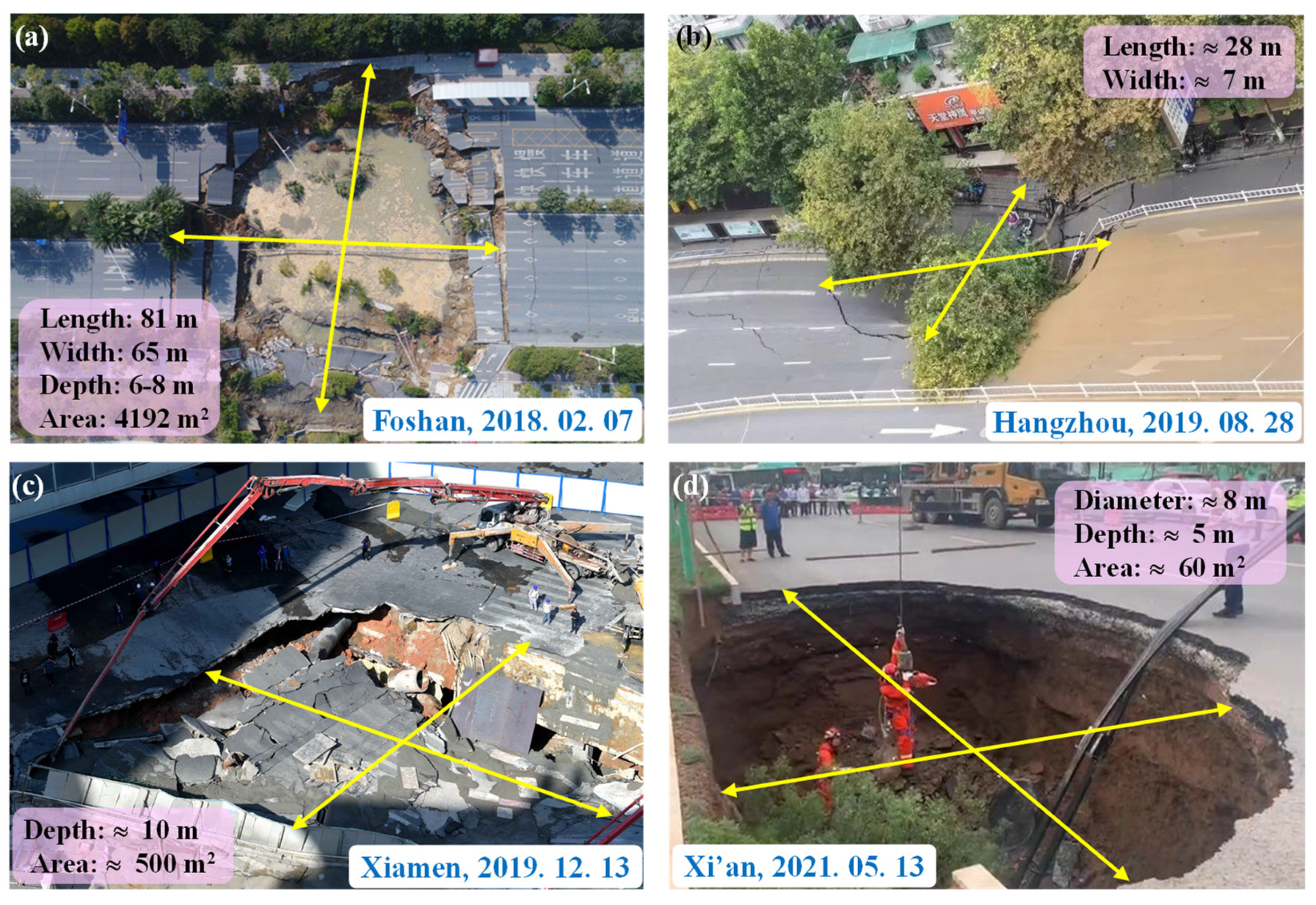
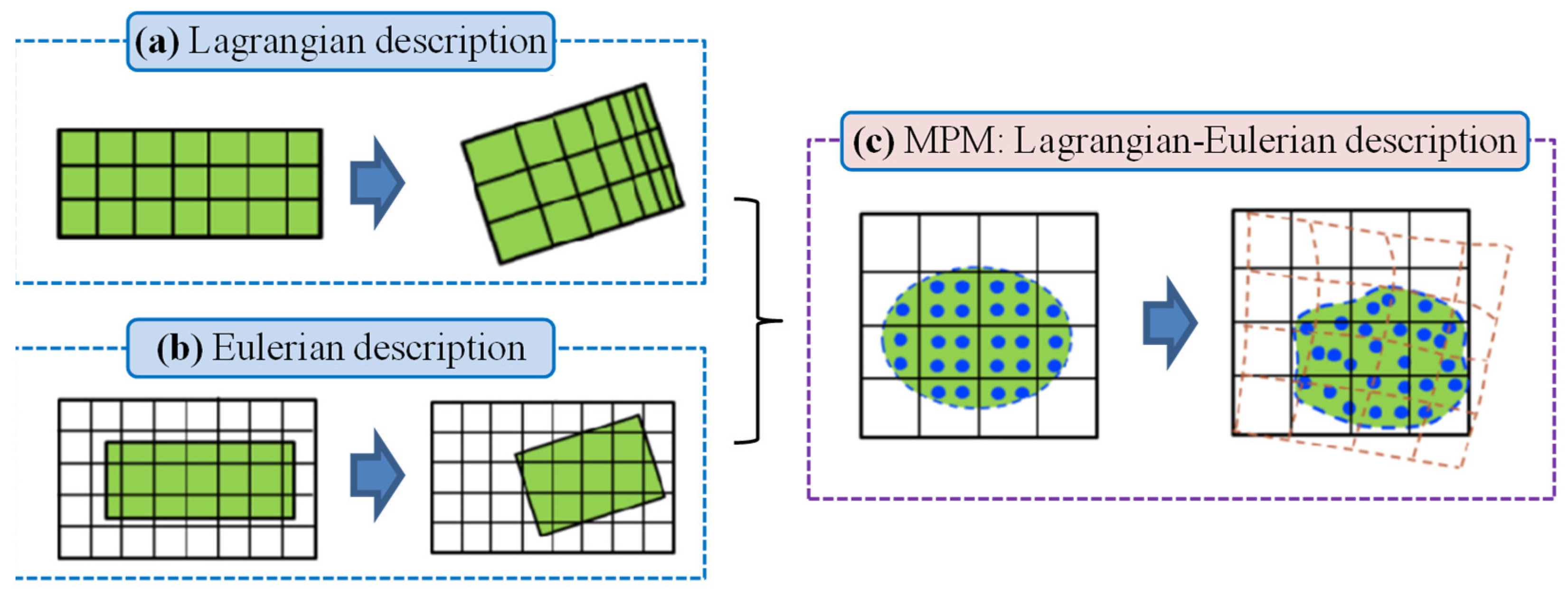

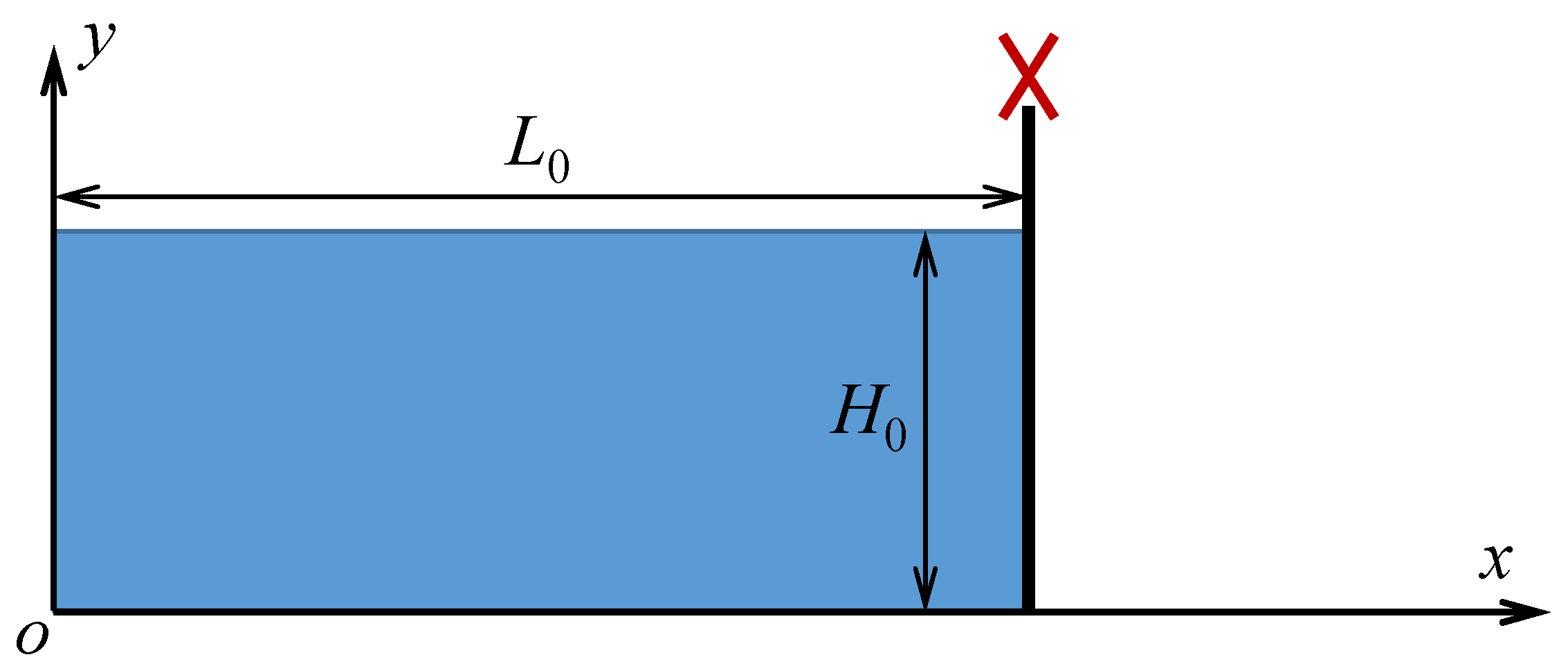






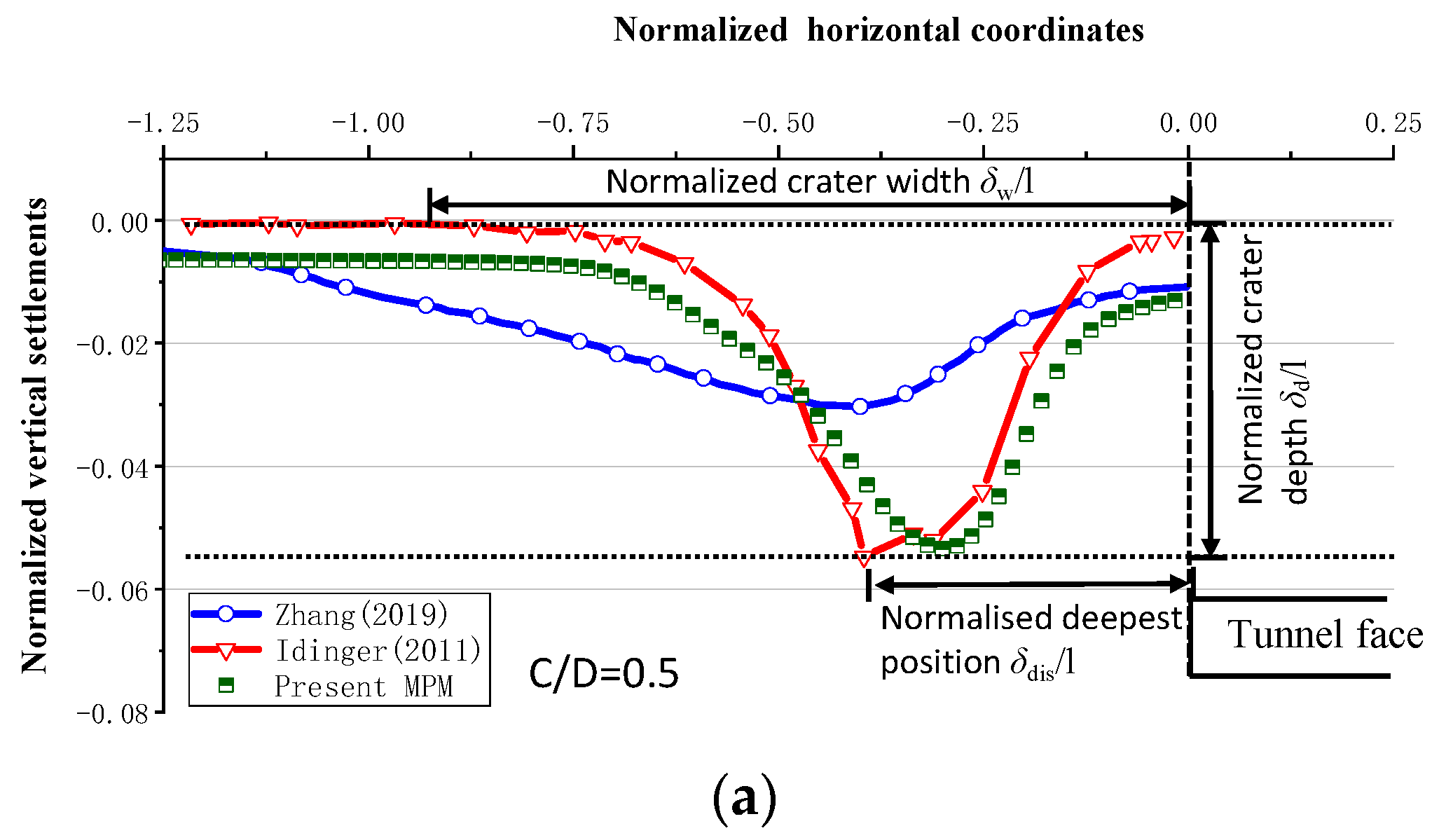




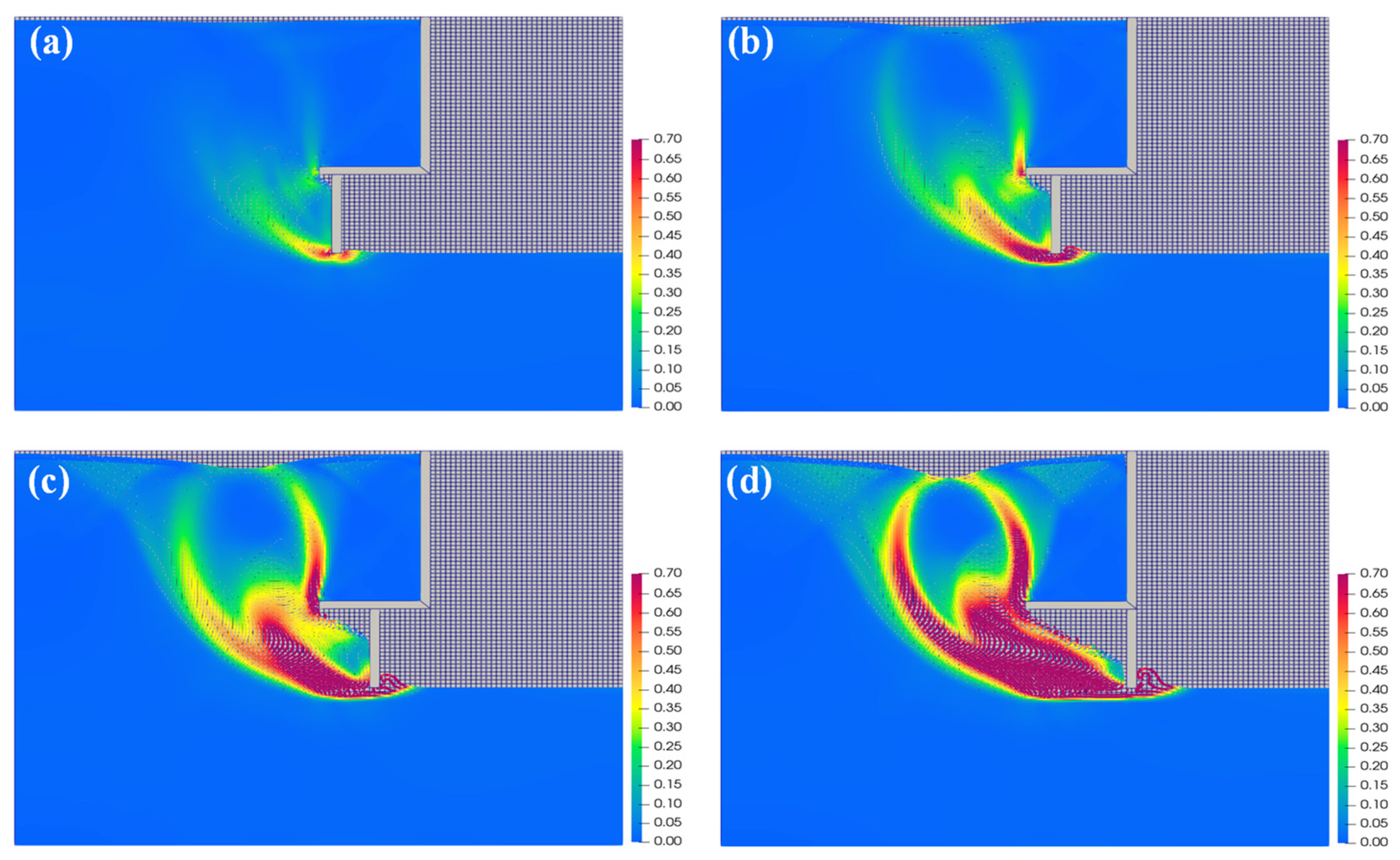
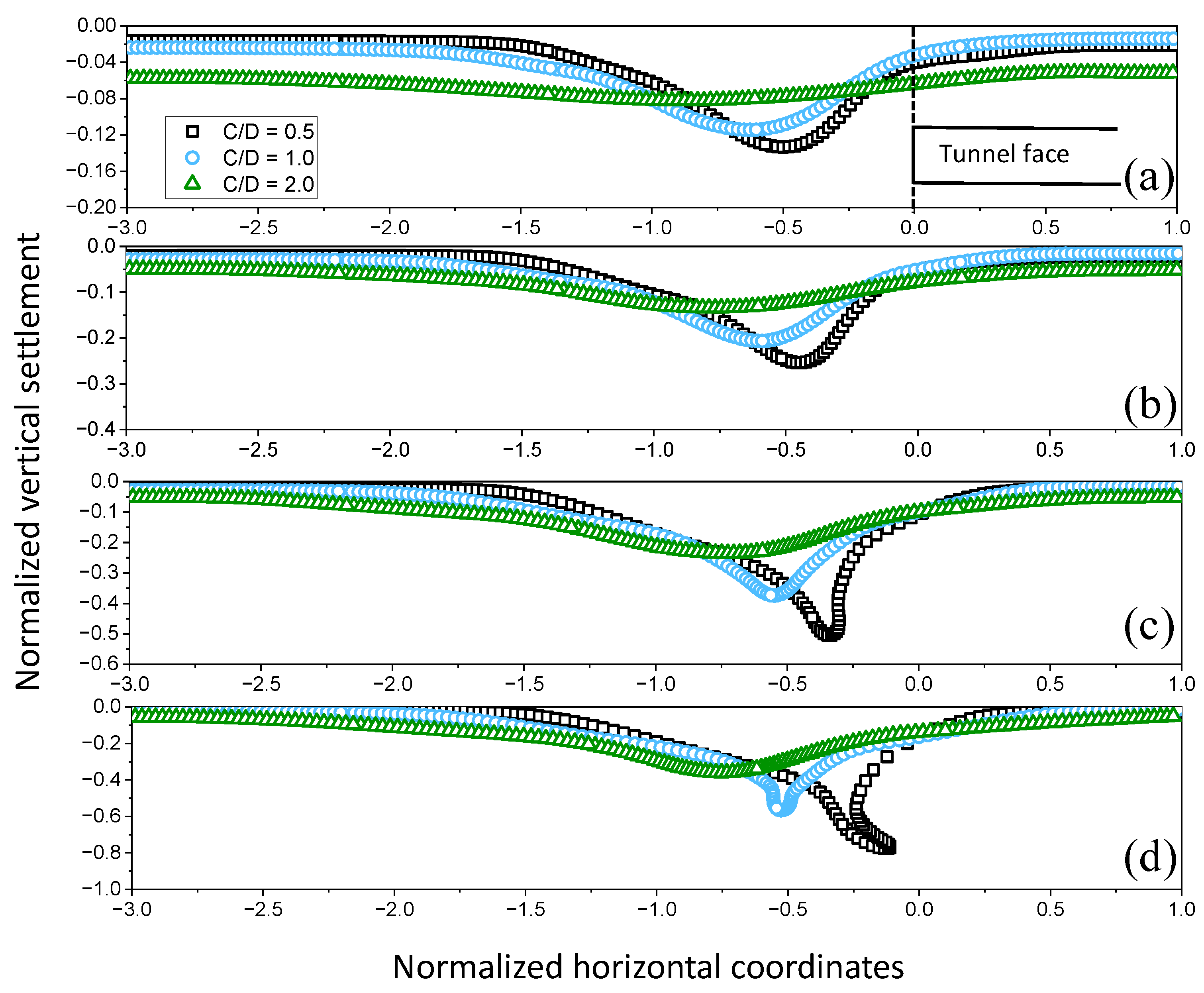

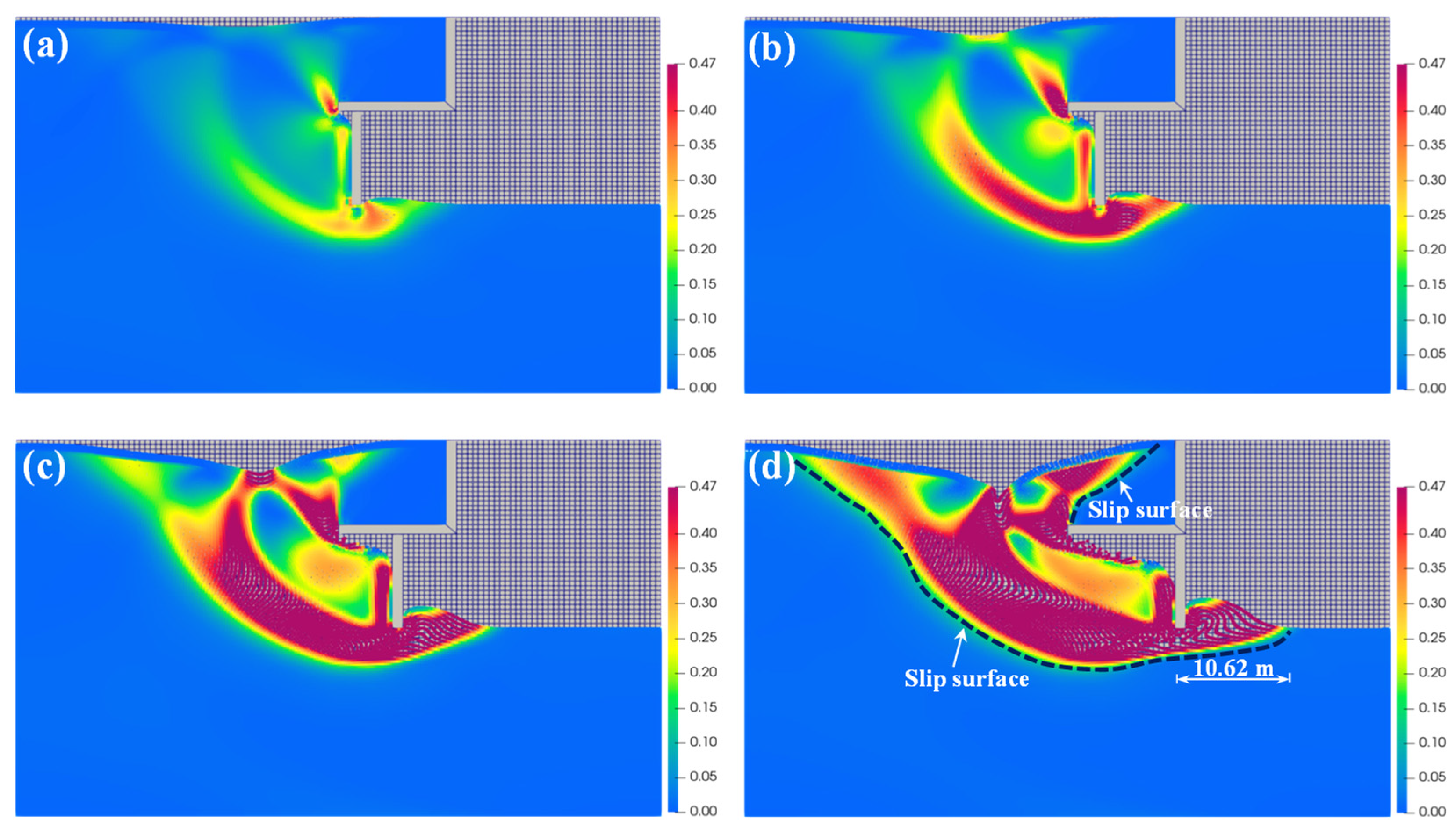


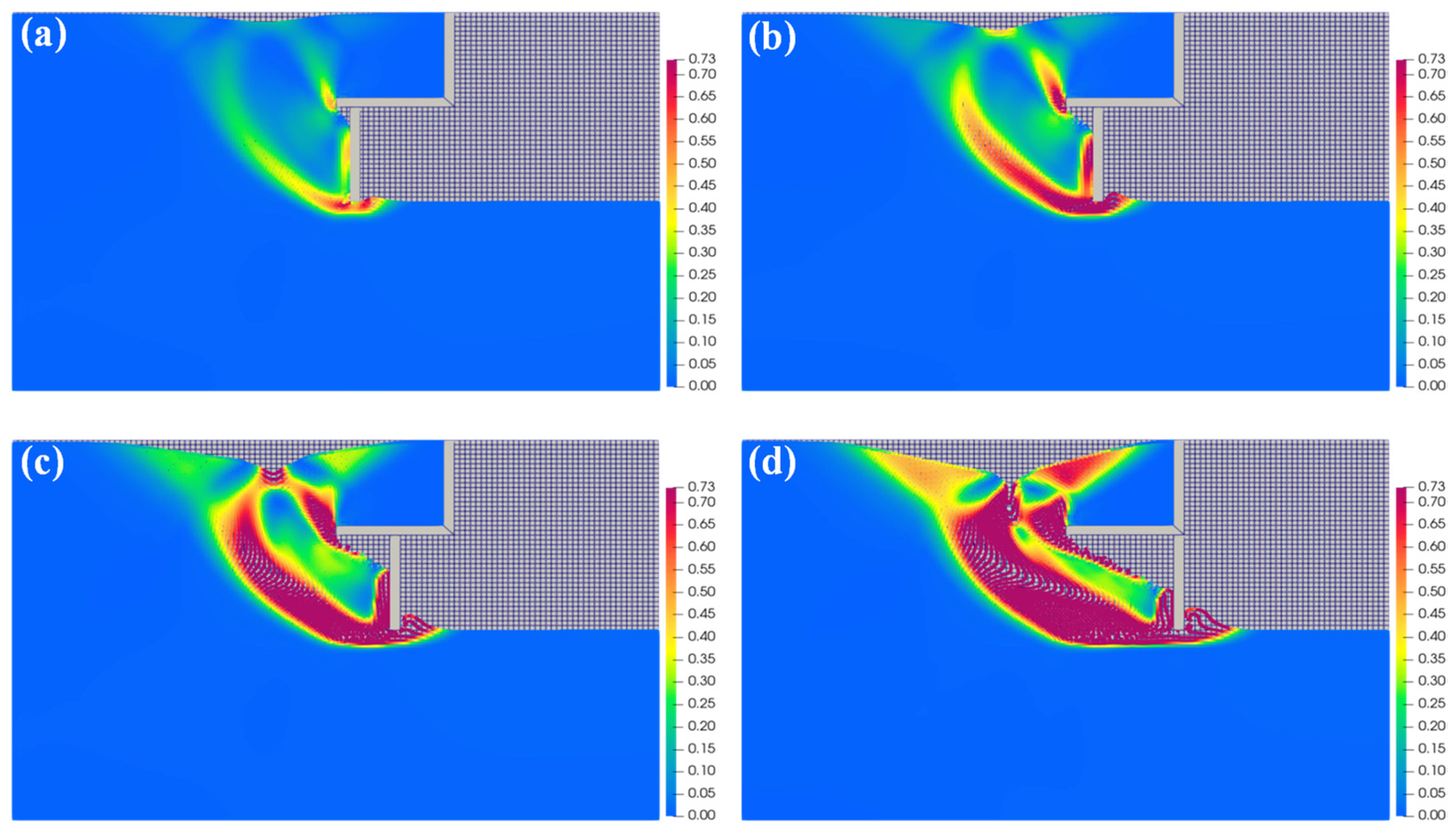


| Parameters | Symbol | Model I | Model II | Model III |
|---|---|---|---|---|
| Tunnel diameter (m) | l | 10 | 10 | 10 |
| Cover-to-diameter ratio | t/l | 0.5, 1, 2 | 1 | 1 |
| Initial cohesion (kPa) | c0 | 10 | 2, 10, 20 | 10 |
| Friction angle (degrees) | φ | 27 | 27 | 10, 27, 40 |
| Young’s modulus (MPa) | E | 20 | 20 | 20 |
| Poisson’s ratio | υ | 0.26 | 0.26 | 0.26 |
| dilation angle (degrees) | ψ | 2 | 2 | 2 |
| Density (103 kg/m3) | ρ | 1.798 | 1.798 | 1.798 |
| coefficient of earth pressure at rest | k0 | 0.35 | 0.35 | 0.35 |
Disclaimer/Publisher’s Note: The statements, opinions and data contained in all publications are solely those of the individual author(s) and contributor(s) and not of MDPI and/or the editor(s). MDPI and/or the editor(s) disclaim responsibility for any injury to people or property resulting from any ideas, methods, instructions or products referred to in the content. |
© 2024 by the authors. Licensee MDPI, Basel, Switzerland. This article is an open access article distributed under the terms and conditions of the Creative Commons Attribution (CC BY) license (https://creativecommons.org/licenses/by/4.0/).
Share and Cite
Luo, H.; Zhang, S.; Sun, M.; Gong, S.; Hu, C. Large-Deformation Modeling of Surface Instability and Ground Collapse during Tunnel Excavation by Material Point Method. Buildings 2024, 14, 2414. https://doi.org/10.3390/buildings14082414
Luo H, Zhang S, Sun M, Gong S, Hu C. Large-Deformation Modeling of Surface Instability and Ground Collapse during Tunnel Excavation by Material Point Method. Buildings. 2024; 14(8):2414. https://doi.org/10.3390/buildings14082414
Chicago/Turabian StyleLuo, Haipeng, Shimin Zhang, Miaomiao Sun, Shilin Gong, and Chengbao Hu. 2024. "Large-Deformation Modeling of Surface Instability and Ground Collapse during Tunnel Excavation by Material Point Method" Buildings 14, no. 8: 2414. https://doi.org/10.3390/buildings14082414





